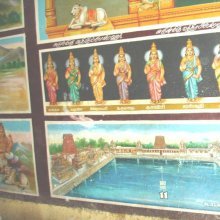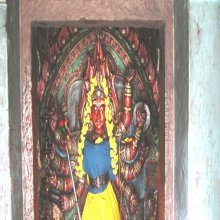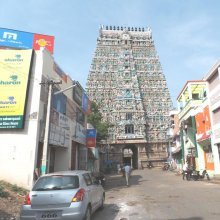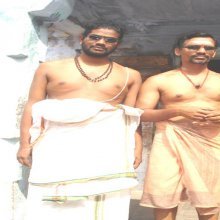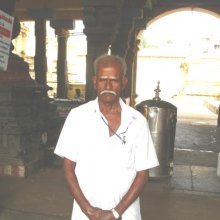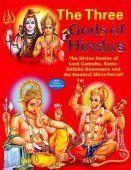Kaveri, Kaverī, Kāverī, Kāveri: 23 definitions
Introduction:
Kaveri means something in Buddhism, Pali, Hinduism, Sanskrit, the history of ancient India, Marathi, Tamil. If you want to know the exact meaning, history, etymology or English translation of this term then check out the descriptions on this page. Add your comment or reference to a book if you want to contribute to this summary article.
Images (photo gallery)
(+1 more images available)
In Hinduism
Natyashastra (theatrics and dramaturgy)
Source: archive.org: The mirror of gesture (abhinaya-darpana)One of the Hands of the Famous Rivers.—Kaverī, the Catura hand. Also see: Vyāvṛttacāpaveṣṭitau.

Natyashastra (नाट्यशास्त्र, nāṭyaśāstra) refers to both the ancient Indian tradition (shastra) of performing arts, (natya—theatrics, drama, dance, music), as well as the name of a Sanskrit work dealing with these subjects. It also teaches the rules for composing Dramatic plays (nataka), construction and performance of Theater, and Poetic works (kavya).
Purana and Itihasa (epic history)
Source: Wisdom Library: Varāha-purāṇaKāverī (कावेरी) is the name of a river mentioned in a list of rivers, flowing from the five great mountains (Śailavarṇa, Mālākhya, Korajaska, Triparṇa and Nīla), according to the Varāhapurāṇa chapter 82. Those who drink the waters of these rivers live for ten thousand years and become devotees of Rudra and Umā.
One of the five mountains situated near Bhadrāśva, according to the Varāhapurāṇa chapter 82. The Varāhapurāṇa is categorised as a Mahāpurāṇa, a type of Sanskrit literature preserving ancient India’s vast cultural history, instructions for religious ceremonies and a whole range of topics concerning the various arts and sciences. The original text is said to have been composed of 24,000 metrical verses, possibly originating from before the 10th century.
Source: archive.org: Puranic EncyclopediaKāverī (कावेरी).—A holy river in South India. Famous sacred places like Śrīraṅga and Kumbhakoṇa are on its banks. The Devī of the river lives in Varuṇa’s assembly worshipping him. (Sabhā Parva, Chapter 9, Verse 20). The Skanda Purāṇa has the following story as to how Kāverī came down to earth: Once Agastya propitiated Śiva at Kailāsa and sought the boon of some water for him to found a sacred place on earth. At the same time Kāverī also was worshipping Śiva. Śiva filled Agastya’s bowl with Kāverī water. Agastya, on his way back from Kailāsa cursed the Rākṣasa called Krauñca and kicked the Vindhya mountain down. (See under Agastya). After overcoming various difficulties Agastya at last reached South India. He sat in meditation with the bowl of Kāverī water before him, and then, at the request of Indra, Gaṇapati, in the guise of a crow came and sat on the brink of the bowl and upset it. The water in the bowl flowed as a river, and that river is the present Kāverī. (Asurakāṇḍa, Skanda Purāṇa).
Source: archive.org: Shiva Purana - English TranslationKāverī (कावेरी) is the name of a sacred river as mentioned in the Śivapurāṇa 1.12, “somehow men must strive to find a residence in a holy centre. On the shores of the ocean in the confluence of hundreds of rivers there are many such holy centres (puṇyakṣetra or tīrtha) and temples. [...] The great river Kāverī flowing from the mountain Sahya is very holy and is said to have twenty-seven mouths. It accords all cherished desires. Its banks are the bestowers of heaven and the regions of Brahmā and Viṣṇu. [...] The devotees of Śiva are the bestowers of Śivaloka and accord cherished desires. [...] When the sun and the Jupiter are in Tulā, the devotee shall take bath in the Kāverī the fruit whereof is the attainment of all cherished desires as stated by Viṣṇu Himself”.
Kāverī is mentioned as one of the seven holy Gaṅgas (saptagaṅgā), according to Śivapurāṇa 1.15. Accordingly, regarding the benefit in the rites of Devayajña:—“[...] a temple, the bank of a holy tank, the bank of an ordinary river, the bank of a holy river and the banks of the seven holy Gaṅgās (saptagaṅgā) are each of ten times more benefit than the previous. The seven holy Gaṅgās are Gaṅgā, Godāvarī, Kāverī, Tāmraparṇikā, Sindhu, Sarayū and Revā. The shores of the sea are of ten times more benefit than the previous. The summit of a mountain is of ten times more benefit than the shores of the sea”.
Source: Cologne Digital Sanskrit Dictionaries: The Purana Index1a) Kāverī (कावेरी).—(River) personified as one of the wives of Havyavāhana (Śamsya) fire; Sangamam in the Narmadā, where Kubera attained siddhi by penance to Śiva. Its greatness described.*
- * Brahmāṇḍa-purāṇa II. 12. 14; Matsya-purāṇa 51. 13; 163. 61; 189. 2-20; Vāyu-purāṇa 29. 130.
1b) The grand-daughter of Yuvanāśva and wife of Janhu; mother of Suhotra. (Sunaha, Brahmāṇḍa-purāṇa); made of one half of Gangā.*
- * Brahmāṇḍa-purāṇa III. 66. 28-30; Vāyu-purāṇa 91. 58.
1c) A R. of the Bhadra country.*
- * Vāyu-purāṇa 43. 26.
Kāverī (कावेरी) refers to the name of a River or Tīrtha (pilgrim’s destination) mentioned in the Mahābhārata (cf. II.9.20, II.9, III.83.20, VI.10.19). Note: The Mahābhārata (mentioning Kāverī) is a Sanskrit epic poem consisting of 100,000 ślokas (metrical verses) and is over 2000 years old.
Source: Ramakrishna Math: A Concise Encyclopaedia of Hinduism (purana)Kāverī (कावेरी) (often called ‘Dakṣīṇagaṅgā’) is one of the seven most sacred rivers of India included in the mantra invoking the seven rivers, at the time of ritualistic worship. [...] There are several stories in the epics and the Purāṇas regarding the river and the river-goddess Kāverī. She was the foster-daughter (known earlier as Viṣṇumāyā) brought up by the king Kavera and hence called ‘Kāverī’. She was also known as ‘Lopāmudrā’ and was given in marriage to the sage Agastya. Once when Agastya was travelling to the south of the country beyond the Vindhya mountains, he was carrying her in the form of water in his kamaṇḍalu (water pot of mendicants) which was upset by a powerful wind near the Sahyādri mountain from where she started flowing as a river. [...] Other stories are similar but add that she was originally a river flowing in Kailāsa, the abode of Śiva.

The Purana (पुराण, purāṇas) refers to Sanskrit literature preserving ancient India’s vast cultural history, including historical legends, religious ceremonies, various arts and sciences. The eighteen mahapuranas total over 400,000 shlokas (metrical couplets) and date to at least several centuries BCE.
Shaivism (Shaiva philosophy)
Source: DSpace at Pondicherry: Siddha Cult in Tamilnadu (shaivism)The river Kaveri.—Maṇimekalai, one of the Tamil epics, mentions that Agastya drank the River Ganges in anger, when the floods destroyed the sacrificial fire in his cottage, and then released it in the name of River Kaveri to the southern lands.

Shaiva (शैव, śaiva) or Shaivism (śaivism) represents a tradition of Hinduism worshiping Shiva as the supreme being. Closely related to Shaktism, Shaiva literature includes a range of scriptures, including Tantras, while the root of this tradition may be traced back to the ancient Vedas.
Kavya (poetry)
Source: Shodhganga: The Kavyamimamsa of RajasekharaKāverī (कावेरी) is the name a locality mentioned in Rājaśekhara’s 10th-century Kāvyamīmāṃsā.—Kāverī is the famous river in the southern India, which rises from a spring called the Candratīrtha on the Brahmagiri mountain in Coorg.

Kavya (काव्य, kavya) refers to Sanskrit poetry, a popular ancient Indian tradition of literature. There have been many Sanskrit poets over the ages, hailing from ancient India and beyond. This topic includes mahakavya, or ‘epic poetry’ and natya, or ‘dramatic poetry’.
Pancaratra (worship of Nārāyaṇa)
Source: eScholarship: Chapters 1-14 of the Hayasirsa PancaratraKāverī (कावेरी) is the name of an ancient region, being born from there represents an undesirable characteristic of an Ācārya, according to the 9th-century Hayaśīrṣa-pañcarātra Ādikāṇḍa chapter 3.—The Lord said:—“I will tell you about the Sthāpakas endowed with perverse qualities. He should not construct a temple with those who are avoided in this Tantra. [...] Nor should he have leprosy, deformed nails, white leprosy, brown teeth, be a consumptive, one born (samutpanna) in Kacchadeśa, or from Kāverī or Koṅkana. [...] A god enshrined by any of these named above (viz., kāverī), is in no manner a giver of fruit. If a building for Viṣṇu is made anywhere by these excluded types (viz., kāverī) then that temple will not give rise to enjoyment and liberation and will yield no reward, of this there is no doubt”.

Pancaratra (पाञ्चरात्र, pāñcarātra) represents a tradition of Hinduism where Narayana is revered and worshipped. Closeley related to Vaishnavism, the Pancaratra literature includes various Agamas and tantras incorporating many Vaishnava philosophies.
Ayurveda (science of life)
Dietetics and Culinary Art (such as household cooking)
Source: Shodhganga: Dietetics and culinary art in ancient and medieval IndiaKāverī (कावेरी) is an important river whose water (jala) qualities are described in the Bhojanakutūhala (dravyaguṇāguṇa-kathana), and is commonly found in literature dealing with the topics of dietetics and culinary art, also known as Pākaśāstra or Pākakalā.—Different types of water (jala) and their properties are mentioned here [viz., in jala-prakaraṇa]. The text explains the qualities of the water of certain important rivers like [viz., Kāverī].

Āyurveda (आयुर्वेद, ayurveda) is a branch of Indian science dealing with medicine, herbalism, taxology, anatomy, surgery, alchemy and related topics. Traditional practice of Āyurveda in ancient India dates back to at least the first millenium BC. Literature is commonly written in Sanskrit using various poetic metres.
Jyotisha (astronomy and astrology)
Source: Wisdom Library: Brihat Samhita by VarahamihiraKāverī (कावेरी) refers to a river belonging to “Dakṣiṇa or Dakṣiṇadeśa (southern division)” classified under the constellations of Uttaraphālguni, Hasta and Citrā, according to the system of Kūrmavibhāga, according to the Bṛhatsaṃhitā (chapter 14), an encyclopedic Sanskrit work written by Varāhamihira mainly focusing on the science of ancient Indian astronomy astronomy (Jyotiṣa).—Accordingly, “The countries of the Earth beginning from the centre of Bhāratavarṣa and going round the east, south-east, south, etc., are divided into 9 divisions corresponding to the 27 lunar asterisms at the rate of 3 for each division and beginning from Kṛttikā. The constellations of Uttaraphālguni, Hasta and Citrā represent the southern division consisting of [i.e., Kāverī] [...]”.

Jyotisha (ज्योतिष, jyotiṣa or jyotish) refers to ‘astronomy’ or “Vedic astrology” and represents the fifth of the six Vedangas (additional sciences to be studied along with the Vedas). Jyotisha concerns itself with the study and prediction of the movements of celestial bodies, in order to calculate the auspicious time for rituals and ceremonies.
General definition (in Hinduism)
Source: Wisdom Library: HinduismKāverī (कावेरी) is a Sanskrit word referring to a dwelling place or resort of the celestial nymphs (apsaras). They live chiefly on earth around rivers or on mountains, as in the courts of all the gods.
In Buddhism
Theravada (major branch of Buddhism)
Source: Pali Kanon: Pali Proper NamesA channel flowing from the Giritalaka tank to Kadduravadhamana.
This channel formed part of the irrigation system of Parakkamabahu I. Cv.lxxix.55.
Theravāda is a major branch of Buddhism having the the Pali canon (tipitaka) as their canonical literature, which includes the vinaya-pitaka (monastic rules), the sutta-pitaka (Buddhist sermons) and the abhidhamma-pitaka (philosophy and psychology).
India history and geography
Source: archive.org: Geography in Ancient Indian inscriptionsKāverī (कावेरी) is the name of a river found in India.—This is the famous Kāverī river of South India. The river is known as “the beloved of the Pallavas”, indicating thereby that a Pallava king ruled here along the banks of the Kāverī river.
Source: archive.org: Shiva Purana (history)Kāverī (कावेरी) is the name of a river and is one of the most sacred rivers which takes its rise from the Sahya mountain. It is said to have many tīrthas, particularly Śiva-kṣetras, on its bank. Skanda-purāṇa I. iii P 6. 98; I. iii u.2.11.
Source: archive.org: Ceylon Branch of the Royal Asiatic Society 1963Kāverī is one of the twenty canal-systems associated with Parakkamasamudda waters that existed in the Polonnaruva (Polonnaruwa) district of Ceylon (Sri Lanka).—The Pūjāvaliya gives the name Mahāsamudra to the Parakkamasamudda at Polonnaruva. The canal system associated with Parakkamasamudda is described and named in the Cūlavamsa as follows:—[...] Kāverī canal, which conveyed water from Giritalākavāpi (present Giritalevava) to Kaddūravaḍḍhamānakavāpi, also called Kaduruvaḍunnā; [...].
Source: Ramakrishna Math: A Concise Encyclopaedia of Hinduism (history)Kāverī (कावेरी) is one of the seven most sacred rivers of India.—Taking its birth in the Brahmagiri hill of the district of Koḍagu (or Coorg) in Karnataka, it flows in the south-easterly direction through the Mysore and the Tanjavur (Tanjore) districts of Karnataka and Tamil Nadu states, ultimately merging in the Bay of Bengal near the small town Kaveripattinam. Its total length is 760 kms. (475 miles). The place where it emerges out of the womb of earth is called Talakāverī.

The history of India traces the identification of countries, villages, towns and other regions of India, as well as mythology, zoology, royal dynasties, rulers, tribes, local festivities and traditions and regional languages. Ancient India enjoyed religious freedom and encourages the path of Dharma, a concept common to Buddhism, Hinduism, and Jainism.
Languages of India and abroad
Marathi-English dictionary
Source: DDSA: The Molesworth Marathi and English Dictionarykāvērī (कावेरी).—f A river in the Carnatic, Cavery.
Marathi is an Indo-European language having over 70 million native speakers people in (predominantly) Maharashtra India. Marathi, like many other Indo-Aryan languages, evolved from early forms of Prakrit, which itself is a subset of Sanskrit, one of the most ancient languages of the world.
Sanskrit dictionary
Source: DDSA: The practical Sanskrit-English dictionaryKāverī (कावेरी).—
1) Name of a river in the south of India; कावेरीं सरितां पत्युः शङ्कनीयामिवाकरोत् (kāverīṃ saritāṃ patyuḥ śaṅkanīyāmivākarot) R.4.45.
2) A harlot, courtezan.
3) Turmeric.
Source: Cologne Digital Sanskrit Dictionaries: Benfey Sanskrit-English DictionaryKāverī (कावेरी).—f. The name of a river, Mahābhārata 2, 372.
Source: Cologne Digital Sanskrit Dictionaries: Monier-Williams Sanskrit-English Dictionary1) Kāverī (कावेरी):—[from kāvera] f. turmeric, [cf. Lexicographers, esp. such as amarasiṃha, halāyudha, hemacandra, etc.]
2) [v.s. ...] a courtezan, harlot, [cf. Lexicographers, esp. such as amarasiṃha, halāyudha, hemacandra, etc.]
3) [v.s. ...] Name of a river in the Dekhan ([according to] to a legend [Harivaṃśa 1421 f., 1761 f.] daughter of Yuvanāśva and wife of Jahnu, changed by her father’s curse from one half of the Gaṅgā into the river Kāverī, therefore also called Ardha-gaṅgā or -jāhnavī), [Mahābhārata; Harivaṃśa; Rāmāyaṇa etc.]
Sanskrit, also spelled संस्कृतम् (saṃskṛtam), is an ancient language of India commonly seen as the grandmother of the Indo-European language family (even English!). Closely allied with Prakrit and Pali, Sanskrit is more exhaustive in both grammar and terms and has the most extensive collection of literature in the world, greatly surpassing its sister-languages Greek and Latin.
Kannada-English dictionary
Source: Alar: Kannada-English corpusKāvēri (ಕಾವೇರಿ):—[noun] name of a river (c. 475 mile or 765 km.) in South India, flowing from the Western Ghats in Karnāṭaka, to southeastward into the Bay of Bengal.
Kannada is a Dravidian language (as opposed to the Indo-European language family) mainly spoken in the southwestern region of India.
See also (Relevant definitions)
Starts with: Kaverika, Kaverike, Kaverimahatmya, Kaverimanal, Kaverimanmiyam, Kaverippattanam, Kaverisamgamamahatmya, Kaveristotra, Kaveritata.
Ends with: Bahyakaveri, Gamgakaveri, Murkkaveri, Priyakaveri, Talaikkaveri, Talakaveri, Vriddhakaveri.
Full-text (+136): Ardhaganga, Marudvrita, Ardhajahnavi, Kavera, Tula-kaverisnanam, Cittiraiccilampan, Sahya, Kaverakanya, Takshinakankai, Kaverika, Vriddhakaveri, Shvetaranya, Adiranga, Kaverimanmiyam, Kaverippattanam, Vriddhakaverimahatmya, Vicakavellam, Kaverimanal, Hemavati, Talaikkaveri.
Relevant text
Search found 60 books and stories containing Kaveri, Kaverī, Kāverī, Kāveri, Kāvērī, Kāvēri; (plurals include: Kaveris, Kaverīs, Kāverīs, Kāveris, Kāvērīs, Kāvēris). You can also click to the full overview containing English textual excerpts. Below are direct links for the most relevant articles:
The Skanda Purana (by G. V. Tagare)
Chapter 29 - The Greatness of the Confluence of Kāverī and Narmadā < [Section 3 - Revā-khaṇḍa]
Chapter 25 - The Greatness of Jābālitīrtha < [Section 1 - Veṅkaṭācala-māhātmya]
Chapter 4 - The Procedure of Kārttikasnāna < [Section 4 - Kārttikamāsa-māhātmya]
Garga Samhita (English) (by Danavir Goswami)
Verse 8.13.61 < [Chapter 13 - A Thousand Names of Lord Balarāma]
Verse 4.19.112 < [Chapter 19 - A Thousand Names of Srī Yamunā]
Tiruvaymoli (Thiruvaimozhi): English translation (by S. Satyamurthi Ayyangar)
Introduction to Section 2.4 < [Section 4 - Fourth Tiruvaymoli (Ati ati)]
Pasuram 10.8.2 < [Section 8 - Eighth Tiruvaymoli (Tirumaliruncolai)]
Pasuram 7.2.2 < [Section 2 - Second Tiruvaymoli (Kankulum Pakalum)]
Abhinaya-darpana (English) (by Ananda Coomaraswamy)
The Padma Purana (by N.A. Deshpande)
Chapter 16 - Kāverī Saṃgama Tīrtha < [Section 3 - Svarga-khaṇḍa (section on the heavens)]
Chapter 11 - A list of sacred places (tīrtha) < [Section 1 - Sṛṣṭi-khaṇḍa (section on creation)]
Chapter 70 - The Vow of Nadī-trirātra < [Section 6 - Uttara-Khaṇḍa (Concluding Section)]
Chaitanya Bhagavata (by Bhumipati Dāsa)
Verse 1.9.136 < [Chapter 9 - Nityānanda’s Childhood Pastimes and Travels to Holy Places]
Verse 2.3.37 < [Chapter 3 - The Lord Manifests His Varāha Form in the House of Murāri and Meets with Nityānanda]
Verse 2.3.108-114 < [Chapter 3 - The Lord Manifests His Varāha Form in the House of Murāri and Meets with Nityānanda]
Related products
